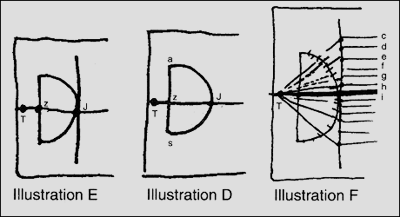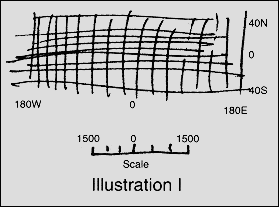 |


|
Lesson 2 Activity 1: Make a Mercator Projection
Follow the directions below to make a close approximation of the normal Mercator projection. A few activities with the map are included to demonstrate the important characteristics of this projection.
Time
One 50-minute period for steps 1-10.
After photocopying in step 11, one 50-minute period for steps 11-14.
Materials needed per person
- Protractor
- Compass
- Ruler
- Two sheets of 11 x 17 inch paper
- Transparent tape
- Sharp pencil
- Fine point pen, preferably black
Procedures

- Tape the two pages together along the I7-inch sides and orient the paper as shown in illustration A, with the tape on the reverse side.
- The joint between the two pieces of paper will be the "equator." Lay the protractor on the paper with the flat side on the left. Place the zero point and the 90-degree mark on the equator (see illustration B). Use the compass to draw a semicircle with a 6-inch diameter, flat side on the left. Mark the center (the zero point, Z) on the diameter. IMPORTANT NOTE: Make all marks lightly in pencil, unless otherwise instructed.
- Using a protractor, mark every 10 degrees around the semicircle (see illustration C). Starting at the top, label these points A, B, C, ..., S.

- Beginning at Z, measure left along the equator 2/5 of a radius (in this case, 1.2, inches) and mark a new point, T, as shown in illustration D.
- Using the protractor, draw the westernmost line of longitude perpendicular to the equator and tangent to the original semicircle at point J (see illustration E).
- Set the spacing of the lines of latitude as follows: With the left end of your ruler on point T, align the right side to point I on the semicircle; mark where this line (TI) intersects the westernmost longitude line. Beginning again at point T, mark points on the westernmost longitude for lines through points H, G, F, E, D, and C (see illustration F). Each point marks 10 degrees of latitude.
- Draw latitude lines parallel to the equator through these new points. To make the latitudes parallel, measure the distances between marks on the westernmost longitude line; copy these measurements and mark equivalent points on the easternmost longitude line. Connect pairs of points (a western and an eastern), preferably beginning closest to the equator.
- Repeat steps 6 and 7 for latitudes south of the equator. Notice that on this projection, lines of latitude are parallel and spacing between them increases away from the equator. Latitudes 90°N and 90°S cannot be shown on a Mercator projection, because they arc infinitely far from the equator (although this approximate construction does not show this).

- Set longitude lines as follows: Measure east 0.5 inches from the westernmost longitude and make a mark on the equator. This represents 10 degrees of longitude. Repeat this step 17 more times, and you will have 180 degrees of longitude. From each point on the equator, use the protractor to draw a perpendicular line. On the Mercator projection, longitude lines are parallel and equally spaced, as shown in illustration G.
- At this point, the map covers only half the planet (a hemisphere). Carefully trace this grid in ink.

- To map the entire Earth, make two copies of the original and join the copies along the one's easternmost line of longitude and the other's westernmost (see illustration H). Lines should connect across the copies. These two lines both represent the Prime Meridian, the line of 0 degrees longitude.
- Label the latitude and longitude lines along the right and bottom of the map. The equator is 0 degrees latitude, and latitude values increase in increments of ten to the north and south. The westernmost longitude line is 180 degrees W; longitude values decrease in increments of ten to 0 degrees at the Prime Meridian, and increase again to 180 degrees at the eastern edge of the map (see illustration H). This map approximates the characteristics of the Mercator projection within about 2 percent.

- Make a bar scale in the margin below the map. A bar scale is commonly centered below the map, in this case, below the Prime Meridian (see illustration I). To determine the scale at the equator, divide the Earth's equatorial circumference (24,902 miles; 40,075 kilometers) by 360 degrees; therefore, each degree of longitude and latitude at the equator equals about 69 mi (about 111 km). Ten degrees of longitude at the equator (about 690 miles) is represented by 0.5 inch on the map; one inch represents 1,380 miles. Draw a line representing 3,000 miles (about 5,000 kilometers).
- Sketch the outlines of the continents as shown on other maps available in the classroom. Plot the course between Columbus' home port and destination; your home town and the western coast of Africa; and the route of an oil tanker from Kuwait to Tokyo, Japan. Notice that you cannot plot polar explorations.
Extension
Obtain a variety of world maps from the school library and compare the properties of the projections. Various atlases may prefer different projections. Which seem to be the most popular projections for world maps? For detailed maps?
|
Intro & Lessons |
Teacher's Guide |
Explorers
|
|
|
 |
|